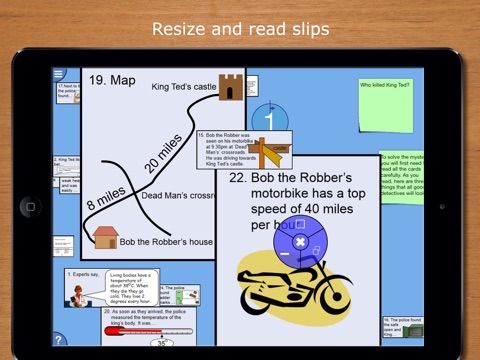
Digital Mysteries: KS2 app for iPhone and iPad
Developer: Reflective Thinking
First release : 12 Nov 2014
App size: 18.69 Mb
Digital Mysteries: KS2 is a cross-curricular app that is unique in allowing pairs to work simultaneously on one iPad with tasks that are mapped to the national curriculum for England.
Users are given illustrated slips of information which they read, organise into groups and move around the screen to show how they’ve came to their answer. This is in response to the open-ended question for each particular task.
Students can generate a PDF report of the session which can be shared or printed, plus they can move to a Reflection Stage. This involves sitting as a group, with their teacher, or as a whole class, and playing back the app session to help them reflect on what they’ve understood, discussed or learned. While students do this, it will also help develop their problem-solving, communication and collaboration skills.
What’s different about this app?
• Truly collaborative: It is unique in that more than one student can interact with it at once
• Curriculum-mapped: Tasks are directly linked to the National Curriculum for England
• Cross-curricular: Mysteries come in various topics plus many are cross-curricular in themselves (e.g. Pip the dog - PSHE/Science/English)
• Record of learning: Students can interact and have fun with exciting technology then generate a printable PDF report of their session which shows what they’ve done
• Reflection: Sessions are automatically recorded so students can playback and discuss what they’ve done, emphasising the importance of the process as well as the outcome
• Speaking and listening: Due to its collaborative nature, each session aligns to this learning goal, plus ‘group discussion and interaction’
• Engagement: Working in pairs adds to the fun experience of problem-solving
• Research: We’ve done years of academic research on how to make the most of touch screens for learning in general, and collaboration specifically
Who is this app for?
Digital Mysteries: KS2 has three tasks as a taster of the variety of mysteries we have an offer. This version is most suited to students aged 7-11 years old, but we also have a KS3/4 app with two tasks included. To see our other mysteries, tap Developer Apps at the bottom of the app details tab - many more are coming soon in computing, history and maths.
It has built-in differentiation which allows the same task to be used differently depending on ability. Most mysteries have three levels which allows a whole class to be working on the same task, yet some groups may have less slips to read or perhaps more hints to help them.
What does a mystery consist of?
• Illustrated slips of information: Short snippets to help students with reading
• Open question: To maximise the potential of collaboration, discussion, and expression of ideas, the nature of the task is usually open ended
• Extras: Most tasks come with personalised hints for those who need them. E.g. suggestions for organising ideas or simpler stage introductions to ease them in
• Description: This gives teachers the information they need to plan their session including the curriculum point each task links to, the advised age range and possible learning outcomes
What mysteries come in this version?
Pip the Dog - PSHE/English/Science
Question: Should Emma be allowed to keep Pip?
Students must decide whether a young girl should be allowed to keep a dog she finds. It has the PSHE and English curriculum in mind plus ‘Life processes and living things: Humans and other animals’ (Science).
The Roman retreat from Hadrian’s Wall - History/English/PSHE
Question: Why did Maximum leave Hadrian’s Wall?
This tells of a Roman Cavalryman posted at Hadrian’s Wall. It maps to ‘the Roman Empire and its impact on Britain’ with chronological facts and information on his life in particular.
King Ted - Maths
Question: Who killed King Ted?
A ‘whodunit’ with suspects, motives and possible twists, students must make many calculations to be able to put forward an argument for the killer.



